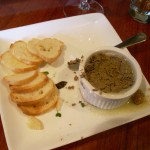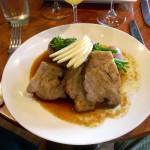We spent a quiet afternoon in our room, reading and relaxing. J. took Sasha to the dog park for a long run, and then we went out for an early dinner.
We went to Liquid Assets Wine Bar, a cozy, classy place with Spanish-influenced food and an excellent wine selection (you hoped I’d say that, didn’t you?) I started with the duck liver pate and a St. Innocent pinot noir, while J. had the ‘taste of spain’: Spanish chorizo, Iberico curado, Romano cheese, Marcona almonds, glazed onions, olives, and grilled bread. The pate was delightful — and very rich. I could only eat 1/2 of it. J. enjoyed his plate, except the olives. There were a lot of olives.
(sorry for not taking this when we started, I’m still new to the ‘taking pictures of your food so you can blog about the meal later’ thing.)
For our main meal, I had smoked chicken with truffle-oil mashed potatoes and broccolini. J. had braised pork should with new potatoes and broccolini. My chicken was very smoked, the texture was very firm, just on the edge of dryness but not going over, and the result was as if I was having smoked *pork*. It tasted great, but I’m not sure how much I liked it. The potatoes, however, were amazing and the broccolini was quite tasty. J’s pork shoulder was pretty fatty and while he didn’t dislike it, he tells me it was just ok. I drank a delightful VistAlba – ’06 Malbec/Merlot from Mendoza, Argentina. It was so good, that I bought a bottle to take home.
For dessert, because we were hoping for something that would really knock us out of the park, I had a white chocolate cheesecake w/ berry compote and J. settled on a Dagoba Lavender creme brulee. These were delicious. I like a thick, dense cheesecake, and that is what I got — very flavorful and the compote was minimal and didn’t hide or overwhelm the white chocolate flavor. J enjoyed his creme brulee — the first he’s ever had made of chocolate.
We walked home, walked the dog, fed her, and then walked back to see Hamlet.
Summarized review of Hamlet: Wow.
This is, hands down, the best adaption of one of Shakespeare’s most well-known plays I have ever seen. We enter the Bowmer theater to find the stage set for a funeral, complete with flag-covered casket on one end and two sections of chairs, one of which is occupied by a man in dark sunglasses and an elegant dark suit. As the theater fills, ushers enter the chapel and begin to take away the chairs, bowing to the man as they pass him. Finally the chapel is empty of all but the man,, his chair, and the casket. The candles are extinguished and he is alone with the corpse. He stands, walks to the casket and, visibly grieving, reaches out to touch it — and the lights go down.
That was the PROLOGUE.
The Old King Hamlet is played by Howie Seago, a deaf actor who communicates in ASL (American Sigh Language). In the scenes (young) Hamlet plays with him, they communicate in ASL, with Young Hamlet verbalizing much of what is being said. But not every line is repeated, and I found it enthralling and enchanting to realize how much I could ‘read’ even though I don’t know any ASL. As a viewer, I found the use of ASL a rich metaphor for the translation of self that occurs when a person dies, but does not leave earth (as it were). Throughout the play, when the actors referred to the dead king, they usually (always?) accompanied their verbal words with ASL, making a rich metaphor for the dead speaking a new (occult, in the sense of not well known) language.
Jeffrey King, a long time favorite of mine, plays the new King by marriage, Claudius. In this interpretation, Claudius is a bit of a blowhard. Larger than life, and full of bonhomie, he booms through scenes while glad handing and glossing over fissures in the firmament.
Horatio, one of the few survivors, is played by the ever-wonderful Armondo Duran. As a ‘supporting’ character, Horatio has a tough role . . .sometimes he is the audiences sane perspective, sometimes he is just Hamlet’s confidante. But throughout he must be strong and yet clearly a product of his time. Duran does it well, with an easy-going, loose-limbed physicality that nonetheless reveals the core of strength within.
Richard Elmore plays Polonius, the befuddled councilor, and Susannah Flood is Ophelia, his doomed daughter. One of the trickier parts to play, Ophelia has to give us — a very modern audience — a reason why she would love Hamlet, go mad, and kill herself. Flood does a wonderful job, infusing her early scenes with humor and intelligence, giving us a glimpse into the strong partner for Hamlet she could be . . . Her middle scenes have an underlying sense of yearning passion that hint at the desperate desire she feels for a man who seems to be spurning her, where once he sought her kisses. Their final scene together takes place in a chapel and it evokes a strong sense of desire and betrayal so well that when Hamlet utters the fateful words “get thee to a nunnery” we can almost hear, as well as see, Ophelia’s spirit (and mind) break.
Dan Donohue’s Hamlet is a brilliant modern creation. He loved/loves his father very much, and can’t quite believe his mother remarried so soon. We have the sense that he’d get over it, except that his father tells him he was poisoned by his uncle, and it is up to him to find revenge. He retreats into madness, looking for an opportunity to prove the ghosts’ case and all around him the people try to cope with politics and guilt and lust.
This is not a sexual Hamlet, there is no sense of incest here. He kisses Ophelia with passion that reveals their mutual lust, and it gives the audience a sense of necking and teenage explorations, all fumbling and haste and frustration. But Donohue himself reveals only a bare leg to the knee, even though his suit is in tatters. His friends, Rosencrantz and Guildenstern are women, who he ‘has loved well.’ But they are clearly lesbians and we wonder if his loving was a menage, or something more cerebral.
Donohue is a brilliant actor, flawless and genuine. His presence on the stage is magnetic, and he is a pleasure to watch as he strides, squats, sprawls and grasps. Each movement mirrors his inner and outer words, making his performance seamless and strong.





